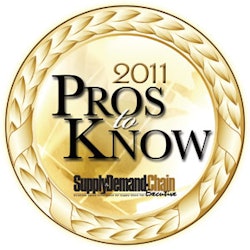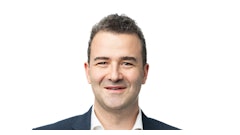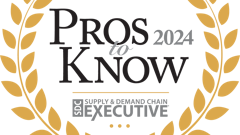
By the Editors of Supply & Demand Chain Executive
The supply chain industry saw a return to something like normalcy in 2010. Sure, it might be a "New Normal" of greater volatility and constraints. But supply chain practitioners in 2010 came out of their recessionary defensive crouch and started taking proactive steps to drive improvements in their operations — even investing again in technologies and services.With the 2011 edition of Supply & Demand Chain Executive's Pros to Know, the magazine is recognizing many of these exceptional supply chain executives at manufacturing and non-manufacturing enterprises who are leading initiatives to help prepare their companies' supply chains for the significant challenges in the year — and years — ahead. These men and women are helping supply chain to be increasingly recognized as a strategic differentiator crucial to meeting the challenges of the "New Normal." Therefore, this year's Pros to Know article offers a roadmap for other leaders looking to leverage supply chain for competitive advantage.
This year's listing also includes the 2011 Provider Pros to Know — individuals from software firms and service providers, consultancies or academia, who have helped their supply chain clients or the supply chain community at large prepare to meet these challenges. These Provider Pros to Know offer thought-leadership that is shaping the supply chain industry and advancing supply chain as a respected discipline.
The men and women included in the 2011 Pros to Know exemplify the talent, knowledge, skills and effort necessary for supply chain leadership. They are an elite group leading the industry, and their own enterprises, boldly into the evolving future.
2011 Practitioner Pro of the Year - The Art of the Beautiful Supply Chain
Pierre Pirard, Executive Vice President for Product Innovation and Global Supply Chain, Elizabeth Arden
As executive vice president for product innovation and global supply chain at Elizabeth Arden, Pierre Pirard has led initiatives that have helped the company meet the challenges presented by a fast-paced and continually evolving industry. "Supply Chain must develop new processes and systems to manage increasing levels of complexity," Pirard says, "as well as ensure that Elizabeth Arden can deliver against its key business metrics."
To continually meet consumer demand, Pirard instituted and implemented a formal sales and operations planning (S&OP) process. A key element of S&OP at Elizabeth Arden is a monthly meeting of key functional stakeholders, including Pirard, and the heads of marketing, sales and finance. They review key business performance metrics and make operational and investment decisions.
"By having a common definition of key business metrics across functions, the team is able to agree on what the metrics are telling them about consumer demand, current inventory levels and lead times to enable them to make operational business and investment decisions," Pirard explains. "Overall, the S&OP process has been transformational for Elizabeth Arden from an efficiency, service level and cost point of view."
Beauty at the Core
Product production is another area where Pirard and his team have made a difference. Elizabeth Arden was founded over a century ago, when a young Miss Arden opened her first salon in New York City and painted its door a bright red to stand out on Fifth Avenue. Today the company's iconic red door is recognized around the world as a symbol of beauty, luxury and quality, and Elizabeth Arden is a global company whose extensive portfolio of prestige skincare, color and fragrance brands are sold in over 100 countries. The company chose to focus its internal expertise on what it does best and view everything else as "non-core."
To support the back-end delivery of products, Elizabeth Arden has partnered with third-party providers. Under Pirard, the company shifted from a tolling contract manufacturing engagement to a turn-key solution, choosing to outsource 95 percent of its contract manufacturing to a series of strategic partners. "We maintain control of key strategic input commodities where we have deep market expertise," Pirard says, "but all other purchasing and supply-chain management is handled by the contract manufacturer."
Elizabeth Arden also partners with third parties for the purchasing and management of all indirect categories, including secondary packaging, marketing, professional and corporate services, and information technology.
Beautiful Savings
The combination of the front-end improvements through the S&OP program and back-end initiatives leveraging outsourcing engagements have benefited Elizabeth Arden from both a cost and cash flow perspective, as well as providing service-level improvements. Thanks to the S&OP program Elizabeth Arden, using inventory as a proxy, has decreased their holdings by 30 percent in the last two years. From a service-level perspective, the S&OP program has helped establish a database that tracks performance by SKU, region and account. This enables efficient analysis of performance and issue/bottleneck identification. In addition, Elizabeth Arden's fill rate has increased from the high 80's percent range to the mid-90's percent range. "Based on the momentum achieved so far, we have the ability to deliver best-in-class fill rate in the near future," Pirard says.
And, as a result of their various outsourcing programs, Elizabeth Arden is seeing significant and ongoing savings on the bottom-line. In secondary packaging, for example, the company is realizing more than 20 percent year-over-year savings. Another area in which Pirard and his team have made a significant improvement is air freight, where Elizabeth Arden has decreased by 50 percent its reliance on and spending on over the past year.
"We are focused on ensuring that all corporate cost reduction initiatives are fully resourced and that we are focused on driving improvements in the pure unit costs of goods and services, not just a few key wins around inventory management," sums up the 2011 Practitioner Pro of the Year.
2011 Next-generation Thought-leader for the Supply Chain — Shekar Natarajan
At the young age of 31, Shekar Natarajan has won accolades and the praise of industry and academicians alike for his innovation in applying scientific management methods to the supply chain with the development of a methodology for "systematic network planning." A frequent speaker and writer on supply chain topics, Natarajan also is the author of numerous articles in industry publications, as well as author or co-author on three books on supply chain topics.
Natarajan currently is working with other industry leaders, including Ron Hammond and Lee Hales, to develop a "supply chain maturity model" aimed at enabling companies to evolve and build roadmaps for the supply chain of the future. Natarajan says that the model is intended to be "the most complete pieces of work pertaining to supply chain maturity models."
At Pepsi, he was a key architect and leader of the company's direct store delivery (DSD) transformation program, which earned first place in the Supply Chain Innovation Award competition from the Council of Supply Chain Management Professionals in 2010. He led Pepsi DSD transformation, providing leadership from a visioning, strategy, system and process standpoint. In addition, Natarajan serves on the board of Colalife, a non-profit organization committed to improving children's health in developing countries by using innovative supply chain concepts to deliver medicine.
Supply and Demand Chain Executive has recently invited him to be a regular contributor of a monthly series, called "Forging a Dynamic, Energetic and Enduring Supply Chain — Hammond & Natarajan Series," to share his thinking with the Supply Chain industry.
For his work in elevating the supply chain field and in helping transform how large corporations think about, and operate, their supply chains, Supply & Demand Chain Executive recognizes Shekar Natarajan as its 2011 Next-generation Thought-leader for the Supply Chain.
2011 PRACTITIONER PROS TO KNOW
Anthony Aming, Business Process Instrumentation and Supplier eProcurement Manager, Enterprise Applications, Baker Hughes
Aming initiated the business process orchestration system for collaboration between the buyers at BHI and more than 600 worldwide suppliers. This Procure to Pay System has helped BHI address their supplier collaboration challenges and ensure on-time product delivery.
Marilyn Anderson, Vice President, Global Planning, Logistics, and Customer Service, Diversey
Anderson set forth on a massive project to support Diversey's global growth, including improving demand visibility, reducing working capital, and implementing a standardized system and supply chain planning processes. The company leveraged technology solutions from Logility for demand planning, inventory planning, supply planning and global supply chain visibility.
Steve Baum, Senior Director, Supply Chain, Quantum Corp.
Steve Baum and his team, responsible for new-product fulfillment and spare parts supply chains, successfully implemented operational initiatives that reduced outsourced transportation, product and warehousing costs and the rate of service inventory growth, while at the same time maintaining 99 percent service level agreement (SLA) performance.
Michael Burke, Director, Supply Chain Planning, Continental Mills
After Continental Mills rolled out Logility Voyager Solutions, it began to reap the benefits as forecast accuracy improved. The supply chain team, led by Michael Burke, then focused on expanding the use of Logility to drive broader results in inventory management, uncovering more opportunities for supply chain improvements.
Cliff Engle, Senior Vice President of Supply Chain, Fender Musical Instruments Corporation
To support Fender's growth, Engle set out to build a more responsive supply chain, with a goal of end-to-end visibility and a comprehensive plan to drive and measure global performance. The company now is able to anticipate changes and react strategically. The results are impressive: service increased by 50 percent and finished goods inventory turns doubled.
Dawn Evans, CEO, Sourcing Interests Group
Under Evans' leadership, SIG offers a starting point for procurement and outsourcing leaders to gain category expertise, supply market information, thought leadership and decision making.
David Foote, CFO, Concept Industries, Inc.
Foote recognized that diversification of the supply chain was a requirement to help insulate from the unpredictability of foreign governments, adverse weather conditions or disasters such as fire. He established a team to evaluate reducing in-process inventory and optimizing order size for just-in-time. This team systematically evaluated the causes of inventory shrinkage and reduced shrinkage to immaterial percentages.
Vonnie French, Dir. of Operations, Palo Alto Networks
Managing the supply chain from end-to-end, Vonnie French has achieved significant efficiency results with a small team while the company has been growing at a significant pace. Her team's capabilities to support customers, both domestically and internationally, are second to none for a company of Palo Alto's size — or even when compared to significantly bigger companies.
Jeff Gallinat, VP, Global Manufacturing Operations, Cisco
Gallinat oversees the Global Manufacturing Organization (GMO) within Cisco's Customer Value Chain Management (CVCM), led by SVP Angel Mendez. The GMO organization is undertaking a number of innovative business transformation initiatives to help position Cisco to more quickly and flexibly respond to growing market and customer complexities. Gallinat has created a geographically decentralized leadership model for GMO to enable Cisco's value chain to be more responsive to the unique needs and requirements of non-U.S. customers.
Jeff Joyce, COO, Ringside
Jeff Joyce is launching Snapfulfil, an SaaS WMS to automate operations that previously remained in many areas manually operated. Moving to a full RF-directed real-time system will enable operations to increase their throughput, speed and order accuracy with fewer resources. He has captured the key performance indicators (KPI) needed to provide a solid cost-benefits analysis when the operation is up and running.
2011 PRACTITIONER PROS TO KNOW (continued)
Mariano Legaz, Vice President, Supply Chain Services — Verizon
Mariano Legaz, working closely with the President of Verizon Services Operations, leads one of the most impactful cost reduction programs in the company. His strategy has been to collaborate with suppliers in the execution of strategic sourcing initiatives, work closely with stakeholders to achieve early buy-in to supply chain programs, and to continuously seek alignment with broader business objectives.
Michael Lennon, Senior Director of Infrastructure, Pepsi Beverage Co.
Lennon identified three areas to be addressed at Pepsi: Service, Operational Excellence and Growth. A new program called DSD Transformation transforms the current warehousing and distribution model by investing in highly automated work centers and moving 75-85 percent of the delivery-vehicle load building upstream from the satellite warehouses and DCs back to centralized automated work centers.
John McCain, Program Manager, Charge Card Service Center Program Office, United States Department of Agriculture
McCain oversaw a collaborative effort between USDA and U.S. Bank to develop a series of custom program management reports aimed at reducing fraud, increasing rebates and ensuring greater compliance. Rebates increased by six figures in the first year of implementation, and check fees dropped by a similar amount.
Brian McCarthy, Vice President of Operations, Nature's Best
McCarthy and his team led a supply chain transformation by implementing Manhattan Associates solutions. After making the transition to a new facility and implementing process training, Nature's Best saw a 75 percent reduction in product handling by staff, 66 percent labor reduction, a 114 percent increase in productivity, and an 11 percent increase in on-time deliveries.
Tom Paolucci, Director of Distribution, Smart & Final Stores, LLC
Paolucci challenges members of his team to be in a "comfortably uncomfortable" state, which implies that they are appropriately challenged and constantly growing. A key focus in the Smart and Final DC is associate engagement — striving to help each and every member of the DC team know that he/she is truly valued, that his/her contribution is truly valued, and that he/she feels part of something larger than themselves.
Harvinder Sembhi, Chief Procurement Officer, Celestica
Sembhi believes that being able to tailor unique supply chain solutions for distinctive customer requirements is what sets Celestica apart from its competition. He focuses on developing supplier partnerships that enable Celestica to deliver the lowest Total Cost of Ownership (TCOO™) to its customers and enabling a supply chain that drives speed, flexibility and responsiveness.
Robin Simons, Senior Director, Indirect Procurement, Loblaw
Simons led the implementation of Iasta's SmartSource SRM to assist Loblaw with e-auctions. Loblaw has embraced the new visibility the tool has enabled, particularly into the details of current contracts and contracts that should be established.
Mike Sparks, Director of Supply Chain Systems, Urban Outfitters
Mike Sparks is responsible for ensuring the overall success of Urban Outfitter's supply chain during a strong period of growth. Under Sparks' leadership, Urban Outfitters went live with Manhattan Associates' software and has seen a 35 percent reduction in total labor, an 80 percent reduction in manifesting and invoicing processes, a 66 percent reduction in turn time through receiving — from three days to less than 24 hours — to a 60 percent rise in putaway efficiency.
Ben Stewart, Enterprise Applications Manager, Inteva Products, Inc.
When Inteva was launched in 2008, one of its most pressing challenges was developing processes and systems to manage a supplier network of approximately 2,500 companies. Inteva implemented a Web-based Supplier Quality Management (SQM) system. Stewart's team then fully integrated that SQM portal into the company's SaaS ERP system at 14 locations in just 12 months. Integrated with the Web-based supplier portal, Inteva and its suppliers can now track quality and delivery through the supply chain, globally.
David Thurston, Associate Vice President for Financial Operations, Emory University
In the past four years, David Thurston has elevated the role of procurement to a higher level of visibility and impact at Emory University. The organization moved from an environment with little control over procurement transactions to a dramatic procurement transformation through his leadership in strategic sourcing and e-procurement initiatives.
John P. Willi, Director, Materials Management, Dana-Farber Cancer Institute, Inc.
Because it is essential for medical professionals to have instant access to supplies, Willi and his team initiated adoption of a VMI system. Working with their most critical suppliers, they decreased inventory levels by up to 50 percent. Some suppliers were able to stabilize their inventory while experiencing a 20 percent increase in demand. The program resulted in more than $1 million in savings and significantly strengthened supplier collaboration.
Mike Williams, Senior Director, Strategic Sourcing — Energy, OfficeMax, Inc.
Williams is implementing best practice applications to help capitalize on supply market opportunities as part of OfficeMax's strategy to drive value through cost leadership, innovation and revenue realization. OfficeMax recently has undertaken a Procurement Transformation with the help of Iasta's software platforms and the Iasta Consulting Group. Using SmartAnalytics, OfficeMax completed an analysis project on $2.2 billion in spend, and almost 97 percent of OfficeMax's supplier contracts have been identified and cataloged.
Clinton Wood, Senior Level Supply Chain Manager, BP, PLC
Supply chain leaders at BP played a critical leadership role in the company's efforts following the Macondo incident. It soon became clear that the size and scope of the spill would require a new approach for the most critical and constrained resources. Wood's role was to establish and lead a supply chain organization that was responsive, flexible and adaptable. While aspects of some of these supply chains existed, they were too small. In many cases capacity had to be scaled upwards of 1,000 percent in a matter of days.
2011 PRACTITIONER PRO TO KNOW — TEAM RECIPIENTS
The Team from Volt Information Sciences, Inc.
- Hae Sebes, Vice President, Diversity Solutions
- Joanne Roth, Vice President of Procurement (CPO) and EPMO
- Pat Damrow, Vice President, Quality Management
The Volt team has led the company's 12 business units to advancing supply chain diversity, cost containment and process improvements. They accomplished their task with a series of initiatives to centralize and consolidate diversity efforts, share data and resources, and support and mentor diversity partners. Using Six Sigma methodologies, they spearheaded formation of Volt's Corporate Procurement Council, which focuses on supplier relationship management, instituting enterprise-wide procurement policies and corporate oversight of supply chain spend, while achieving cost efficiencies across the enterprise. Other initiatives that impact Volt's supply chain include initiating the Quality Council, a guiding coalition of more than 20 Volt leaders from all business units to broaden cross-divisional collaboration on global quality initiatives.
More Practitioner Teams
Navistar — Ed Melching, Director, Global Logistics, Navistar; Neal Cunningham, Manager, Strategic Sourcing and Engineering, Navistar; Jeff Rivera, Account Director, Menlo Worldwide Logistics; Ben Bauman, Global Logistics Operations Manager, Navistar; Greg Steen, Strategy Manager, Navistar; Bryan McMahon, Finance Manager, Navistar; Mike Greene, Operations Director, Menlo Worldwide Logistics; and Josh Mosgrove, Finance Director, Menlo Worldwide Logistics.
Oxbo International Corporation — David Hogan, Don Britt and Karen Vasser.
Safelite Glass Corp. — Michael T. Bradsher, Director of Accounting/Manufacturing & Distribution Controller; with Kemp Edwards, DC Manager ; Bobby W. Sanders, Jr., IT Support; Andy Scott, DC Shift Manager; Robert Tyner, Inventory Control Specialist; John Moore, IT (Retired); and Randy McCombs, IT.
UGL Services — William (Bill) Portuese, Senior Director of Procurement; with George Doolin, Purchasing Systems and Category Manager; Jeff Malin, Purchasing Category Manager; Greg Zifcak, Purchasing Category Manager; and Jannat Kiyemba, Purchasing Assistant.
2011 PROVIDER PROS TO KNOW
Gene Averill, President & CEO, Avercast, LLC — Averill has long been on the leading edge of forecasting science and practice, and he continued his commitment to innovation by launching a forecasting and demand planning system 30 years after he entered the forecasting software business.
Joey Benadretti, President, SYSPRO USA — Benadretti believes that the recession will be the catalyst for even the smallest manufacturers and distributors to abandon spreadsheet-based tools and deploy the solutions necessary for the agility to adjust more rapidly to market conditions.
David Benjamin, CEO, Locus Traxx — Benjamin focuses on helping food companies ensure the safety and quality of their foods while those foods are in transit. He developed technologies for an inexpensive monitoring and reporting platform that allows shipments on the road to communicate their status and location continuously.
Fabrizio Brasca, Vice President, Global Logistics, JDA Software Group, Inc. — Brasca believes that companies must ensure their supply chain planning and optimization technology initiatives maximize business investment returns.
Robert F. Byrne, President and CEO, Terra Technology — Supply chain can better align with a company's broader corporate strategy, says Byrne, by publicizing how supply chain initiatives directly impact corporate objectives.
Frank Camean, President and CEO, 4SIGHT Supply Chain Group — Supply chain is critical to a company's success, but Supply Chain leaders must ensure that their senior management team understands that so that all functions feel invested as much in Supply Chain's success as in their own.
Ned Chamberlain, Vice President - Solutions Delivery, Integration Point, Inc. — Chamberlain believes companies should use solutions to provide real-time supply chain information and visibility to all areas of the organization to ensure management understands supply chain's critical role.
Frank J. Cirimele, Director of Products & Services, Cass Information Systems, Inc. — The key to managing a global supply chain, Cirimele says, is real-time access to key performance data, along with the expertise to rapidly understand the drivers for these data. Companies should look to solutions that deliver real-time, cleansed data.
Charles Clark, CEO, Rosslyn Analytics — Clark champions the use of low-cost spend analysis reporting capabilities that can change with a company's evolving business environment and deliver a unified view of spend intelligence.
Elizabeth Connell, Director Product Development, Integration Point, Inc. — To meet customer needs with a smaller workforce, Connell sees three key tasks that companies can perform: automation of data feeds, electronic filing of data, and less use of customized software.
Norman Conway, President, Prorizon Corporation — Conway champions pushing quantifiable and actionable data tracking the success of cost containment and supply chain initiatives down to managers and end-users.
Doug Damico, CPSM, Senior Director, Professional Services, CombineNet, Inc. — Damico has helped companies implement methods to negotiate with key incumbents within e-sourcing initiatives to balance service and capacity commitments from key suppliers with ensuring lower prices.
Ann Drake, CEO, DSC Logistics — Drake runs one of the largest privately held logistics and SCM companies in the U.S., and she is an articulate advocate for including Supply Chain at the highest levels of corporate decision-making.
Gene Eubanks, CEO & President, Acsis, Inc. — Eubanks has led his company to form a strategic partnership with Cognex Corporation, Omega Design and Nosco to enable pharmaceutical and bio-tech organizations to meet looming new Federal mandates for the pharmaceutical supply chain.
Jessica Fenlon, Manager, Professional Services, CombineNet, Inc. — Security is the top challenge for transportation customers in 2011, and Fenlon advises buyers to ask carriers to quote security measures and costs separately, and to make security a focus of the RFI at the beginning of a sourcing process.
Jerome Gerber, Vice President of Client Solutions, Volt Consulting Managed Service Programs — Gerber recommends Procurement and HR increase dialogue with executive leadership on ways to initiate new (or improve existing) services supply chain management processes and practices.
Matt Gersper, President, Global Data Mining — Gersper focuses on solutions to combine customs transactional data with other data to provide a blueprint to corrective actions, helping eliminate costs.
William Gindlesperger, Chairman and Chief Executive Officer, e-LYNXX Corporation — Gindlesperger has introduced (and patented) a new technology for buying customized (specification-defined) goods and services, resulting in predictable cost reductions of 25-50 percent.
William L. (Skip). Grenoble, Executive Director, Senior Research Associate, Center for Supply Chain Research, The Smeal College of Business, The Pennsylvania State University — A "one size fits all" approach to supply chain management no longer works, advises Grenoble. Managers must continually adapt based on a clear understanding of outcomes from the firm's S&OP process.
Frank Hamerlinck, Executive Vice President, Research and Development, Descartes Systems Group — By using Service Oriented Development of Applications (SODA), , Hamerlinck says, logistics-intensive organizations can bring incredible agility to integrated business processes.
Bill Harrison, President, Demand Solutions — Product volatility presents an opportunity for companies where Forecasting and Supply Chain can keep pace with change and provide market insight to help uncover new opportunities.
Kate Harrison, Quality Systems Manager, Volt Consulting Managed Service Programs — Where companies are hesitant to hire back full-time workers laid off in the downturn, Harrison says, they are relying on the flexibility and scalability that well-managed contingent workforce programs can deliver.
Brian Hodgson, Chief Marketing Officer, Kewill — Hodgson advises that companies should look for software that gives them better control and visibility of their processes within their organizations as well as across their supply chains.
Dan Hunstad, Senior Systems Analyst, Metafile Information Systems — Because of tightened budgets and reduced staffs, Hunstad believes that one of the most significant challenges facing his customers in the coming year and beyond will center on negating inefficiencies surrounding invoice reconciliation.
Al Jacobs, Vice President & COO, Puridiom — Jacobs advises companies to start their procurement transformations by focusing on capturing spend to gain visibility and to measure and improve their purchasing performance. Focus on building a solid process, he says, and then bring in the appropriate solution to enable that process.
2011 PROVIDER PROS TO KNOW (Continued)
Marc Kalman, Chief Executive Officer, eZCom Software Inc. — More than ever, SMBs need access to best-of-breed tools at an affordable price. Kalman believes that superior customer service coupled with innovation is essential in helping SMBs optimize their business to become more productive and successful.
Ron Keith, CEO, Riverwood Solutions — Keith warns that supply chain executives too often focus on a broad number of key performance metrics equally, rather than driving improvements and performance in areas with the greatest impact.
James V. Kelly, C.P.M., CEO, JVKellyGroup, a D&B Company — Kelly advises that procurement groups that make the most of diverse talents will have what it takes to stay ahead.
Anne Kohler, COO and Executive Vice President, The Mpower Group — Kohler says that Supply Chain can align with a company's broader strategy by ensuring that the investments they are making in technology, competency development, etc. reflect those broader goals.
George E. Krauter, Vice President, Storeroom Solutions, Inc. — Krauter educates companies and their supply chain leaders on the impact indirect/MRO materials have on the supply chain.
Jim Lawton, President, Supply Management Solutions division of D&B, D&B — Since playing an influential role in creating the supplier risk management market, Lawton has seen demand for actionable supplier intelligence explode.
Rich MacInnes, President, Net Results Inc. — "Mr. MRO" to many in the industry, MacInnes is a recognized expert on MRO materials management and supply chain processes.
Thuy Q. Mai, CEO, DiCentral — Thuy Mai helps customers manage growth through EDI enablement and by simplifying their EDI processes.
Maren Martens, Dr., Axxom Software AG — Experts in network optimization, Martens and the Axxom team helped customers design lean and efficient supply chains to realize savings and increase their performance.
Bill McLennan, President, Global Operations, ModusLink Global Solutions — McLennan helps customers execute best practices for labor, health and safety, environment, management system and ethics.
Mick Mountz, Founder and CEO, Kiva Systems — As e-commerce makes all commerce faster and more price-competitive, Mountz says the focus has evolved beyond optimizing the shopping experience to optimizing the fulfillment experience.
Jill Natusch, Vice President, Client Services, Integration Point, Inc. — Natusch believes companies can better align supply chain with their broader corporate strategy by working closely with the internal customs compliance group. This can ensure that parts are classified accurately, which helps expedite arrival and/or shipment of goods into and out of the U.S., getting goods to customers efficiently and inexpensively.
Kevin North, President & CEO, Dyadem — North focuses on risk management and understands the ripple effect that supply chain disruptions can have on manufacturing, distribution or process execution. He help companies identify, mitigate and take measures to manage and prevent the many risks to which they are vulnerable
Anne Omrod, President and CEO, John Galt Solutions — Omrod believes that by improving their S&OP process, manufacturers can achieve increased visibility, tighter integration with daily operations, and improved collaboration with customers and suppliers.
Jeff Pepperworth, President Reverse Logistics, Inmar — Pepperworth says that the best solutions combine consulting, software services and operations to help clients win by achieving their goals. Effective returns programs reduce supply chain touch points to drive costs from the returns process.
Jim Preuninger, CEO and Co-founder, Management Dynamics, Inc. — Preuninger says that global trade management is critical for implementing cost-cutting strategies, opening the doors to new foreign markets, and operating legally and compliantly around the globe.
Dalip Raheja, CEO and President, The Mpower Group — Raheja has been testing his "Next Practices" approach on clients for the past year, already achieving exceptional results that were significantly beyond what the clients were already seeing with their best practices methodologies.
Sergio Retamal, President, Global4PL Supply Chain Services — Retamal works to ensure that processes and goals are in line and, more important, that they make sense in the short, medium and long terms. It is hard to question clients, but, he says, that is what the client looks for in a consultant.
Walter Santiago Junior, Director, Latin America, Flash Global Logistics, Inc. — Santiago is an expert at supporting companies in the Brazilian market, having been instrumental in establishing Flash Global Logistics' presence in the country, and he leverages more than 10 years of experience managing service parts logistics throughout Latin America.
Wayne Usie, Senior Vice President, Retail, JDA Software Group, Inc. — Usie believes that effective retailer/manufacturer collaboration provides an opportunity to increase revenue margins by quickly adjusting product and inventory strategies based on ever-changing buying patterns.
Robert Vormittag, President, Vormittag Associates, Inc. (VAI) — Vormittag says that improving customer service while maintaining a just-in-time inventory level is critical to meeting business objectives. As a result, companies are embracing innovative technologies to achieve their goals.
Jeff Wallingford, Vice President Supply Chain Strategy, Riverwood Solutions — The first question of strategy is "who are you?" as a company. Supply chain is as integral to who the company is as engineering or marketing or sales or finance, says Wallingford. The existing supply chain didn't randomly appear — it was created as a result of the company's actions, presumably in line with the company's goals at some point in its history.
Rich Wilson, President and Chief Operating Officer, CombineNet, Inc. — Wilson believes companies should look for ways to leverage and complement existing sourcing and procurement suite investments so they can better manage their data and get more spend under management by speeding and simplifying the sourcing process for all spend areas.
Team IHS — Companies must command supply chain transparency and precise visibility to the manufacturers, parts, substances and other commodities they use. To do so gives them agility to respond to economic, customer, consumer, and regulatory pressures. It also gives them transferability to swiftly mitigate risk, avoid cost, and ensure continuity of supply. Not doing so leaves them vulnerable to avoidable costs from suppliers and be seen as a keeper of excess or non-compliant inventory. It also exposes them to latent risks such as supplier failures, the use of conflict minerals and hazardous substances, or victim of counterfeit part issues. 2011 is about transparency, enablement, and risk mitigation.
Team IHS includes:
- Don Lesem, VP, Global Products and Services, Design and Supply Chain Solutions, IHS Inc.
- Glenn Bassett, VP Business Development, Design and Supply Chain Solutions, IHS Inc.
- Rory King, Director, Global Product Marketing, IHS Inc
- Steve Noth, Sr. Director, Standards Products & Content, IHS Inc.
- Amy Van Schaick, Product Consultant, IHS Inc.
- Cindi Hines, Sr. Director, Standards and Regulations, IHS Inc.• Greg Wood, Sr. Product Manager, IHS Inc.
- Scott Wilson, Sr. Content Strategist, IHS Inc.• Ron Crean, Commercial Director, IHS Inc.
- John Mothersole, Principal - Industry Practices Group, IHS Global Insight
- Tom Keyserlingk, Director North American Compliance, IHS Inc.
- Brian Schirano, Subject Matter Expert, IHS Inc.
MORE PROVIDER PROS TO KNOW
Omer Abdullah, Managing Director, The Smart Cube
- Jennifer Amys, CEO, UpNet Technologies
- Joe Andraski, Pres. & CEO, Voluntary Interindustry Commerce Solutions (VICS) Association
- Mike Anguiano, Chairman, CVM Solutions
- Michael Armanious, Pres., Datex Corporation
- Donny Askin, CEO, Arigo
- Albert Avalos, SVP, Fortna Inc.
- P.J. Bain, CEO, PrimeRevenue
- Cindy Barlow, VP, Global Sales, Spend Radar
- Tom Beaty, Pres. & CEO, Insight Sourcing Group
- John Blascovich, VP, A.T. Kearney
- Scott Bolduc, Snr. Supply Chain Strategist, SPS Commerce
- David Borowski, Snr. Associate, Pace Harmon
- Jon Bovit, Chief Marketing Officer, CVM Solutions
- Mireia Brancos, Managing Director of Sales - Northeast Region, Iasta
- Bob Brooks, VP, Technology, ProcureStaff Technologies
- Toby Brzoznowski, EVP, LLamasoft
- David Bush, CEO, Iasta
- David Clevenger, VP, Corporate United
- Chad Collins, VP, Marketing & Strategy, HighJump Software
- Joe Critchley, VP, Sales & Business Development, Trade Extensions
- Brian Daniels, CEO, Spend Radar
- Bethany Dekker, VP, Product Management, CVM Solutions
- Sean Delaney, Managing Director, Iasta UK
- Steve Delity, CEO, Rapid Micro Biosystems
- Charles Dominick, SPSM, SPSM2, Pres. & CPO, Next Level Purchasing, Inc.
- Richard Douglass, Global Industry Executive, Manufacturing & Logistics, Sterling Commerce
- Brent Eiland, EVP, Insight Sourcing Group
- Steve Ellet, Principal, Supply Chain Strategy Practice, Chainalytics
- Todd Erickrud, VP, Logistics, Schneider Logistics
- John Evans, Managing Partner, Denali Group
- Justin Fogarty, Online Community Manager, Ariba, Inc.
- George Fowler, VP, Supply Chain Consulting, Spinnaker
- Mitch Free, MFG.com Leadership, MFG.com
- Michael Gaggiano, EMEA Marketing & Professional Services Practice Leader, ICG Commerce
- Matt Gersper, Pres., Global Data Mining
- Jeff Gower, Pres. of Global Supply Chain Services, Brightstar Corp.
- Dion Graham, VP, Line of Business Procurement - North America, SAP
- Josh Green, CEO, Panjiva
- Annette Groenink, COO, The Strive Group
- Irv Grossman, Founder & Pres., Chainnovations
- Andrew Hadland, SVP & General Manager, Exel Transportation
- Udo Hassa, CEO, Alengis Strategic Consulting
- Chuck Hatsis, Pres., Surge Consulting
- Greg Johnsen, EVP, Marketing, GT Nexus
- Michael Johnson, Chief Information Officer, Trade Wings
- Mike Jones, SVP, Armada Supply Chain Solutions
- Alpar Kamber, Managing Partner, Denali Group
- Jeff Karrenbauer, Pres., INSIGHT, Inc.
- Ronan Lavelle, Founder, Dolphin Software
- Paul Lavery, Director of Solutions Enablement, Axway
- Michael Levie, Snr. Director - Consulting, Global eProcure
- Peter Lugli, Snr. Director of Working Capital Management & Business Development, Ariba, Inc.
- Garry Mansell, CEO, Trade Extensions
- Ashif Mawji, Pres. & CEO, Upside Software Inc.
- Andrew S. McCall, VP Strategy, Plan4Demand Solutions Inc.
- Matt McCarrick, Managing Director of Professional Services, Iasta
- Mike McClelland, Pres., North American Transportation Management, UTi Worldwide, Inc.
- Mike McGuigan, CEO, Elemica
- Trevor Miles, Director of Thought Leadership, Kinaxis
- Mark Millar, Managing Director, M Power Associates
- Chayan Mukherjee, LMP Lead Integration Architect, CSC
- Michael Notarangeli, VP, Field Operations, Choice Logistics, Inc.
- Louise O'Sullivan, CEO, Prime Advantage
- Justin O'Toole, VP, Fortna Inc.
- Dan Powers, VP, Sales, CVM Solutions
- Ralph Pryor, Vice President of Client Services, Hubspan
- Patrick D. Quirk, Pres. & CEO, Emptoris, Inc.
- Chetan C. Raniga, General Manager, Americas, Trade Extensions
- Charles R. Rapier, Snr. Director, Supply Chain Analytics, VHA Inc.
- William J. Rehring, Pres., Director of Operations, TOPS Software Corporation
- Laura Rokohl, Chemicals Industry Supply Chain Manager, Aspen Technology
- Niklas Ronnback, Pres., CDC Supply Chain & Managing Director EMEA NE, CDC Software
- Jeff Ross, VP, Consulting, FORTE
- Howard Rosenberg, CEO, B-Stock Solutions, Inc.
- Robert A. Rudzki, Pres. & CEO, Greybeard Advisors LLC
- Ari Salonen, General Manager, North America, Basware
- Dan Sanker, CEO & Pres., CaseStack, Inc.
- G. Satish, Snr. Director - Industry Solutions, TAKE Solutions Inc.
- John Sharkey, VP, Supply Chain Management Consulting, Spinnaker
- Jai Shekhawat, CEO & Founder, Fieldglass
- Greg Silich, CEO, CVM Solutions
- Steve Simmerman, VP, Business Development, Next View Software, Inc.
- Charles N. Smart, Pres. & CEO, Smart Software, Inc.
- Conrad Snover, Partner, Denali Group
- Robert Steinberg, Director of Client Success, CVM Solutions
- Jason Stern, Pres. & COO, Selectica
- Paul Strzelec, CEO, Digital Tempus
- Vijay Takanti, VP, Security & Collaboration Solutions, Exostar
- Jennifer Taylor, Snr. Solutions Consultant, Spend Radar
- Todd Thompson, VP & General Manager, Exel Transportation
- Bruce Tompkins, Executive Director, Supply Chain Consortium, Tompkins Associates
- Jason Treida, COO, Iasta
- Rod True, COO, Spend Radar
- Sandy Tungare, CEO, Vistaar Technologies, Inc.
- Rajesh Voddiraju, Pres., CVM Solutions
- Terry Wellesley, Executive Managing Director & Group Head Corporate Payment Sales, BMO Spend & Payment Solutions
- Robert Wiedmaier, CEO, Container & Pooling Solutions (CAPS)
- Jeff Woody, Director of Customer Support, SciQuest, Inc.
- YRC Worldwide Government Solutions, Government Solutions Team, YRC Worldwide (Tim Johnson, VP, Government Solutions; Kevin Davies, Government Enterprise Solutions Executive; Brian Carter, Government Enterprise Solutions Executive; Ashley Stroud, Sr. Director of Marketing; Chris Monachino-Perez, Pricing Manager)



























